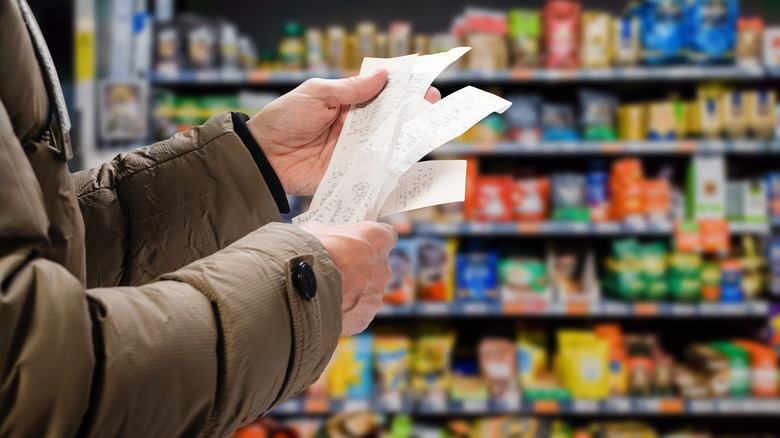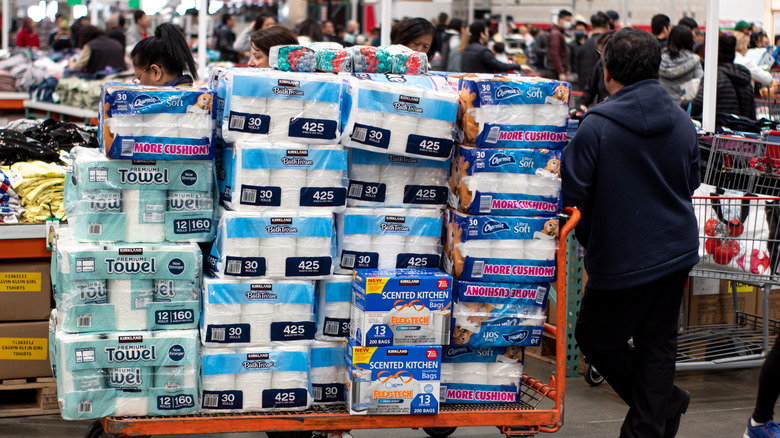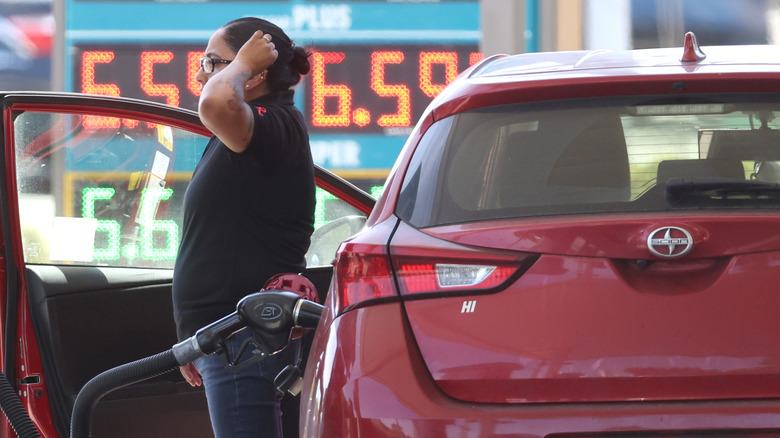New Research Shows Rising Gas Prices Affect Where People Shop For Food
It's no secret the cost of living in the U.S. has been getting drastically more expensive lately. Sugar, seafood, and wheat are among the staple food resources plunged into a state of scarcity and gross price increase in recent months. The Biden administration has launched plans to ease inflation by stimulating agriculture trade with U.S. farmers, but food prices are directly connected to the rising price of gasoline. Nationwide, gas prices rose by almost 50 cents in the last month alone, per The New York Times, and they aren't just affecting your morning commute — your groceries might be next.
According to the 2022 Grocery Shopper Trend Report by FMI, a food sales analytics artificial intelligence system, modern consumers are aiming to spend less on food and take fewer trips to the store. The recent rise in food and gas prices is driving shoppers away from traditional grocery stores and toward alternative markets: namely wholesale clubs and dollar stores. In the report, FMI says 80% of consumers remain "regular" shoppers at traditional grocery stores -– but now, 65% of consumers shop at mass retailers, 44% shop at club stores, and 31% frequent the dollar store for grocery needs. Although this changing trend might seem inconsequential, FoodNavigator-USA predicts it could influence the way food and drink manufacturers think about product distribution.
A shift from supermarkets to bulk clubs, dollar stores
The key idea here is repeat business, since FMI's numbers pulled data from where consumers report doing their regular shopping. Per the report, only 40% of shoppers in 2022 identify a traditional supermarket as their "primary store" versus 49% in 2019. Similarly, club shoppers rose from 5% to 9%, and mass shoppers increased from 24% to 30%.
The COVID-19 pandemic substantially influenced consumer shopping behaviors. Many folks are still feeling the lingering aftereffect of 2020's scarcity mindset. In fourth-quarter 2021, bulk retailers like Costco and Sam's Club saw a 26.6% rise in sales and an 18% rise in volume from 2019, per The Wall Street Journal. According to Food Network, consumers are also still spending more time at home, which spurs higher grocery sales and less eating-out expenses. The increased ease and accessibility of food-delivery services like DoorDash and meal delivery services, it says, likely contribute to the convenience of the at-home trend.
Bloomberg, meanwhile, reports restaurant visits per person in the U.S. is the lowest it's been in 28 years: Most Americans ate out 185 times in 2021, versus 216 times on average in the year 2000.
Other markets could be affected next
Udayan Bose, CEO of NetElixir, a digital marketing agency, says the continuing era of food-shortages post-pandemic might have cemented the scarcity mindset in consumer buying habits, via The Food Institute. The news outlet also points out surfacing variants of the coronavirus, like omicron, further limited access to certain grocery items.
Plus, in recent months, the Russia-Ukraine conflict has led to mass food shortages, skyrocketing inflation, and import costs on goods across markets. The conflict overseas has caused an infamous rise in gas prices, which has (perhaps surprisingly) swung a heavy ax into snack food sales. According to the National Association of Convenience Stores, 44% of drivers filling up at the pump also come inside the gas station to purchase cigarettes, a drink, or a snack.
These convenience stores account for 80% of all gas purchased in the U.S., generating $475 billion every year, per CNN. Now, these convenience stores might be a "canary in a coal mine" for what's in store for supermarkets. When consumers can hardly afford to fill up their cars, impulse buys like that bag of beef jerky at the gas station checkout counter are the first thing to go.


